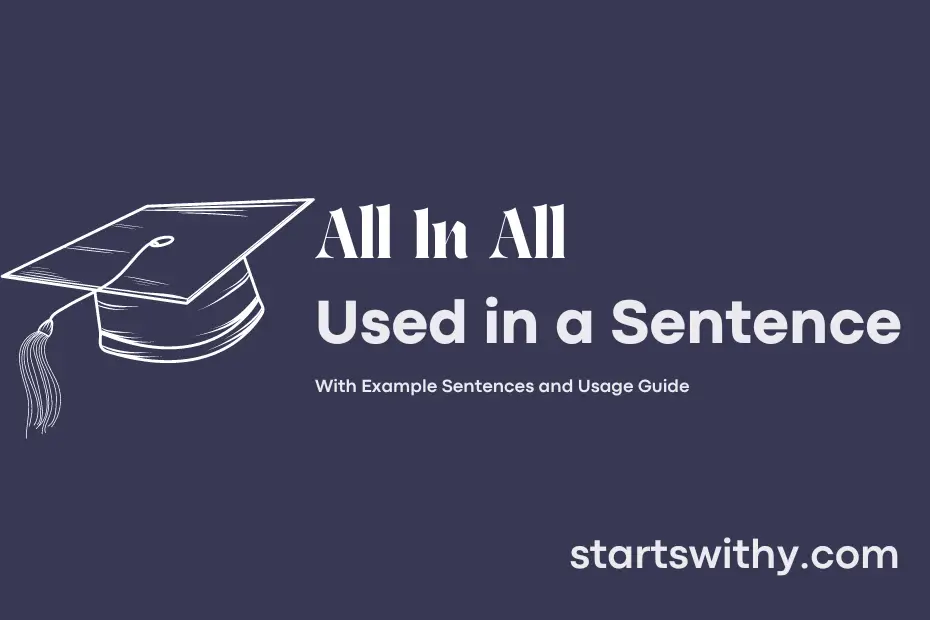Have you ever come across the phrase “all in all” in your reading or conversation and wondered about its meaning and usage? “All in all” is an idiomatic expression that is used to summarize a situation or overall opinion, often indicating a final conclusion or assessment.
This versatile phrase can be employed to wrap up a discussion, highlight key points, or provide a general opinion. Understanding how to use “all in all” effectively can enhance your communication skills and help you convey your thoughts concisely and accurately.
7 Examples Of All In All Used In a Sentence For Kids
- All in all, we had a fun day at school.
- We played many games, and all in all it was a great time.
- All in all, we learned a lot in class today.
- We saw many animals at the zoo, and all in all it was an exciting trip.
- All in all, we had a delicious meal for lunch.
- We sang songs and danced, and all in all it was a wonderful party.
- All in all, our friends helped us with our project.

14 Sentences with All In All Examples
- All in all, choosing the right major is crucial for a successful career in India.
- Indian college students face many challenges, but all in all, the experience is rewarding.
- Balancing academics and extracurricular activities can be tough, but all in all, it’s worth the effort.
- All in all, networking with professionals in your field can help pave the way for future opportunities.
- Budgeting is essential for college students in India because, all in all, money management is a valuable skill.
- It’s important to prioritize self-care and mental health because, all in all, a healthy mind is key to academic success.
- All in all, participating in internships can provide valuable real-world experience and open doors to future job opportunities.
- College life in India can be overwhelming at times, but all in all, it’s a time for personal growth and development.
- In a competitive job market, building a strong resume is crucial because, all in all, first impressions matter.
- All in all, staying motivated and focused on your goals can help you overcome any obstacles you may face in college.
- Time management skills are essential for college students because, all in all, juggling multiple responsibilities can be challenging.
- All in all, forming study groups with classmates can enhance your learning experience and improve academic performance.
- Building a professional network early on in your college years is important because, all in all, connections can be invaluable in your career.
- All in all, seeking guidance from mentors or professors can provide valuable insights and help you navigate the college experience effectively.

How To Use All In All in Sentences?
All In All emphasizes the overall conclusion or assessment of something. When using All In All in a sentence, start by providing a summary or generalization of a situation or topic, followed by your opinion or final thoughts on the matter.
For example:
- ” All In All, the project was successful despite some challenges along the way.” This sentence summarizes the project’s outcome and provides an overall assessment.
- ” All In All, I believe that communication is the key to a healthy relationship.” This sentence gives a general opinion on the importance of communication in relationships.
Remember to use “All In All” at the beginning or end of a sentence to signal that you are providing a final assessment or conclusion. It can help to tie together different points made in the sentence or paragraph.

Furthermore, using All In All can also convey a sense of totality or completeness, making it a useful phrase to wrap up your thoughts or arguments.
In summary, when using All In All in a sentence, remember to provide an overall perspective, opinion, or conclusion on the topic being discussed.
Conclusion
All in all, the phrase “all in all” is a versatile expression that is commonly used to sum up a situation or provide a final assessment. It is often found in discussions where a conclusion is being drawn or an overall judgment is being made. As seen in the sentences provided, “all in all” is a convenient way to encapsulate key points and bring a discussion to a close.
Whether used to highlight the positives and negatives of a situation, convey a general opinion, or provide a final overview, “all in all” serves as a handy phrase to wrap up discussions succinctly. Its simple yet effective use makes it a valuable addition to any conversation where a comprehensive summary is needed.



